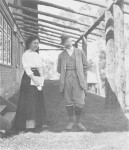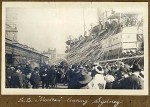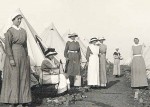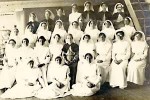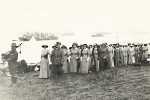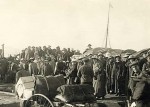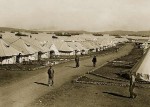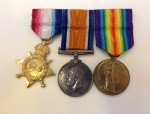BLUNDELL, Madeline Patricia Petrie
Patricia Blundell was one of five surviving children (four daughters, one son) born to Martin Petrie Blundell and his wife Emily (nee Lineker) between 1871 and 1890. Melbourne-born Martin was employed by the Bank of Australasia on leaving Melbourne Grammar School in 1861. From 1882 until ill-health forced his retirement in 1899 he was manager of the bank’s Melbourne branch. In that position he experienced, he said, the ‘most varied conditions’ – prosperity, drought and rabbit plagues, ‘the madness of the land boom in 1889-90 and … the succeeding collapse, culminating in the terrible financial crisis of 1893’ (Argus, 8.7.1901, p6). Broken in health by the physical and mental strain, he retired in 1899 and died whilst abroad with his wife and daughter (possibly Patricia) in 1901.
Patricia (‘Patty’, 'Pattie') Blundell and her family mixed in high social circles in Melbourne. They lived in ‘Chastleton’, a large house in Toorak, valued at £6000 in Martin’s estate, the home of Martin’s considerable art collection (Argus, 8 July 1901, p6). The women of the family attended parties at Government House in the late 1890s and early 1900s, their names appearing in the social columns of the papers as both hosts and guests among Melbourne society house parties, balls and ‘at homes.’
In her late 20s, Patricia turned to nursing as a profession, training at the Children’s Hospital in Melbourne. She was by then the only unmarried daughter. She completed the hospital’s requirements in 1912 and those of the Royal Victorian Trained Nurses Association in February 1914.
In October 1914, Blundell was ‘engaged as a Nurse at the Royal Military College [Duntroon] at £100 per annum, with food and free quarters’ (Royal Military College, Matron and Nurse MP367/1 359348, National Archives of Australia). RMC had been trying to appoint a ‘Nursing Sister, 1st Class’ for several months but the salary offered (£75-85) and conditions (isolation, loneliness, divided authority) had not proved attractive. Blundell was interviewed in Melbourne in late Sept/early October 1914, and appointed.
War Service
Blundell resigned in April 1915 to enlist in the Australian Army Nursing Service. Her brother Martin had applied to enlist in January 1915 and embarked on 28 May – that may well have been the catalyst for her decision.
She gave her enlistment address as ‘East Melbourne’, referring presumably to a boarding establishment, trained nurses home or hospital (there being many of each in East Melbourne).
She left Melbourne on the SS ‘Mooltan’ ten days before her brother embarked. Her unit comprised medical officers and nurses sent as reinforcements for the 3rd Australian General Hospital as casualties from the Dardenelles campaign escalated by the thousand. Despite the shortage of medical staff in Egypt, the unit was sent to England and then Egypt, then rushed to the island of Lemnos in the Mediterranean. At 100 kilometres from the fighting at and around Gallipoli, Lemnos was far closer for receiving the sick and wounded than the hospitals in Egypt. A number of Australian, British and Canadian military hospitals were set up on the island in 1915.
Patricia Blundell served on Lemnos where conditions initially were appalling. Sick and wounded from the disastrous Gallipoli campaign were treated under the most difficult of circumstances. The story of 3 AGH on Lemnos, with the privations of equipment, food and most basic comforts for patients and medical staff, is now becoming well known. Heat, flies, lack of water for washing and the nursing of physical and psychological injuries required great stamina and determination. The diaries of nurses there, including Matron Grace Wilson and Sisters Anne Donnell and Olive Haynes, are a permanent record of the initial debacle and the improvement in conditions.
Blundell’s patients were the battle casualties and sick evacuated from the Dardanelles campaign. Patricia’s brother, Private Martin Blundell, fought in the campaign but escaped injury. He recorded in a notebook the weather, bombardment, illness, hunger and filthy conditions as well as the mundane routine between fighting (‘Peninsula Diary’, Martin Blundell Papers, State Library of Victoria). He was a trenchant critic of the entire operation. In a letter smuggled out to his mother, he wrote of ‘blunders … terrible lack of organization and the utter ineptitude of the officers …’ (Letter to his mother, 13 Jan 1916, Martin Blundell Papers, State Library of Victoria).
Martin’s unit was evacuated to Lemnos in December 1915, and he surprised and delighted Patricia by turning up unexpectedly at her hospital. To him Lemnos was like paradise. ‘This place’, he wrote, ‘assumes all the delights of arcadia to us … [with] plenty to eat and drink … oranges in abundance. Chocolate and coffee to drink. Got my clothes washed for the first time in six weeks.’ He described ‘Pattie’ as ‘thinner but in good nick’.
Pattie enjoyed regular visits from Martin over the next ten days. He came by boat or waded across at low tide. He enjoyed chocolate, Christmas puddings and other delights. But it could not last. Martin’s unit embarked for Egypt on 23 December, leaving him ‘very annoyed that we are unable to have Xmas together.’
With the evacuation of troops from the Peninsula at the end of 1915, 3 AGH was no longer required on Lemnos. In early 1916 it relocated to Abbassia outside of Cairo.
3AGH remained in Abbassia for some months. The unit diary shows that generally the hospital was not inundated with patients. At times it functioned as a casualty clearing station, transferring troops on to general hospitals. Mostly however its patients were awaiting transport back to Australia as ‘men who should never have been enlisted’ (3AGH, War Diary, July 1916). During this time, Patricia also nursed sick and wounded troops in transit, on hospital trains and the hospital ship ‘Guilford Castle’ which operated between Malta and Cairo. She would also have met Martin on his leave March 1916 before he embarked for France.
In September 1916, 3AGH packed up and moved to the Kitchener War Hospital in Brighton, England. Blundell and her fellow nurses looked after wounded troops from the Somme. Some were “very difficult” cases and the work was “very hard” according to nurses there (Bassett, Guns and Brooches, p.58). The nurses’ living conditions were also difficult, their quarters in a nearby school where they were “fearfully cold”. The frozen ground over which they walked to the hospital led to some nurses being hospitalised with chilblains (Bassett, Guns and Brooches, p.58; emhs.org.au/person/frey/maud_josephine).
Blundell transferred in January 1917 to the 2nd Australian General Hospital stationed at Wimereux in France.
Patricia spent a year at 2 AGH. The unit’s war diary was extremely brief but the recollections of the matron, Ethel Gray provide some indication of the work and conditions when Blundell was on the staff:
I can scarcely close my last report on the work of the Nursing Staff of No. 2 Australian General Hospital without paying a tribute of praise to the excellent work which has been done by the Sisters. I joined the unit on December 9th 1916, so was here during the severe Winter of 1916-17, when the bulk of our patients were in tents, and the Sisters worked under many disadvantages.
The intense cold, the frozen water pipes, and the lack on more than one occasion of coal, were all things that might have given an excuse for grumbling, but through the whole season the Sisters worked on day and night duty cheerfully, making the best of things, and going about with a smile.
In April of 1917, we had our first great rush of surgical work. Patients came to us in hundreds from the severe fighting of Vimy Ridge. Work was intensely heavy, convoys and evacuations occurring many times daily. Never once did the zeal and energy of the Sisters fail.
My greatest difficulty with the staff at this time was to be sure that each Sister was allowing herself proper time for meals and sleep.
Apart from the Nursing work, the Sisters have taken a personal interest in the boys in the line, keeping in touch with them in many ways, and trying to make them feel “The touch of Home” through all the warfare and strike.
Should no further work be found for us in England or on this side, we will return to our own land, feeling glad to have been permitted to stand by the side of our soldiers, and proud to have had a share in the great struggle for freedom and right (2AGH, War Diary, Feb 1919).
During January 1918, tent wards had to be closed because they could not be heated. Blundell succumbed to bronchitis and was sent back to London at the end of January. She spent several weeks in hospital (Blundell, Service Record).
Blundell did not return to France. Instead, she was attached to the 1st Australian Auxiliary Hospital in Harefield. Staffed mainly by Australian personnel, the auxiliary hospitals developed specialist services for their patients, the majority of whom were awaiting repatriation back to Australia. ‘Harefield became an ENT centre, the centre for a consulting radiologist, for massage (physiotherapy) specialists, for specialist repair surgery, for blinded casualties and general cases not suitable for other auxiliary hospitals’ (Rupert Goodman, Our War Nurses: The History of the Royal Australian Army Nursing Corps 1902-1988, pp51-52).
Patricia was nursing there when her brother Martin was killed in action in France in April 1918. Presumably they had seen each other in March, when Martin enjoyed two weeks’ leave in England (Martin Blundell, Service Record). No doubt Patricia found it very hard to believe that just a few weeks later, he was dead, killed when shellfire blasted and demolished his dug-out and made recovery of his remains impossible. A week after Martin died, their youngest sister Sophie died in Victoria. Their aunt in England died the same week.
Patricia had been on active service almost three years. She had been ill, and then endured the loss of two siblings and an aunt on opposite sides of the world within a week. To comfort her grieving mother, Patricia Blundell returned to Australia. She set off from England in July 1918 on the ‘Barunga’ in charge of a small group of nurses caring for hundreds of invalid troops. Soon after leaving England, the ‘Barunga’ was torpedoed by an enemy U-boat in the Bay of Biscay, and sunk. Blundell, her nurses, and all the troops and crew were rescued by their destroyer escort. The sinking and the bravery/bravado of the troops were widely reported in the Australian press. There was scant reference to the nurses, mainly that they were first into the lifeboats. However, the Wanganui press in New Zealand quoted an officer on board as saying ‘“The four nurses on board were just lovely. Their only concern was the welfare of the sick”’. The report went onto say that ‘Matron Blundell set a splendid example, though severely shaken by the explosion’ (Wanganui Chronicle, 16 August 1918).
Blundell re-embarked soon after on the transport 'Boonah' and reached Australia in September 1918.
A medical examination in November showed her to be 'very tired out' (Blundell, Service Record). She was recommended for discharge as permanently unfit, and discharged on 31 March 1919. She was nearly 40.
After the War
One immediate task for Blundell after the war was her insurance claim relating to the sinking of the ‘Barunga’. Like everyone on board, she lost all her clothing, kit and possessions. When Blundell applied for insurance to cover her losses, the company demanded proof she was on the stricken ship. Settling the claim took two and a half years.
Details of Patricia Blundell’s personal and professional life after the war are sketchy. She kept her nursing registration current for some years, so presumably maintained her profession and may have worked intermittently at least. Unlike many returned nurses, she was financially fortunate. Her mother died in 1925, leaving Patricia over £4000, the largest share of her estate.
Such a substantial amount would have given Patricia considerable independence and freedom. The electoral rolls show she lived at a number of addresses between 1920 and the late 1950s, including the family home in Upper Macedon, Toorak, Mosman (NSW), and Malvern. From the late 1940s if not earlier, she lived with her sister Sybil and Sybil’s husband, John Winter. She travelled abroad several times, as late as 1955 (when aged 75), in first class accommodation. In 1929, for example, she 'spent a very happy time travelling in Germany and Italy' before travelling on to Paris and London (UNA VolXXVII (8), 1.8.1929, p239).
By the early 1960s, she was living at Poolman House, a substantial home in South Yarra (Melbourne) that had been converted into a nursing home for genteel elderly ladies. She subsequently moved to Cambrai Private Hospital in Balaclava where she spent the remainder of her life.
Patricia Blundell died on 27 November 1968, aged 88, and was privately cremated. She had outlived her four siblings (Argus, 30.11.1968, p47).
Exhibition Panels
Patricia Blundell featured in the East Melbourne Historical Society's exhibition 'Gone to War as Sister: East Melbourne Nurses and the Great War' (2015) can be seen at on the EMHS website at
Gone to War as Sister - exhibition panel 12
Gone to War as Sister - exhibition panel 14
Thanks to Faithe Jones and her database nurses.ww1anzac.com for reference to the Table Talk photograph of Patrica.
Peter Fielding initiated the research and sourced the selection of photographs. Janet Scarfe expanded Patricia's story before, during and after the Great War.
Janet Scarfe
Adjunct Research Associate
23 November 2016


